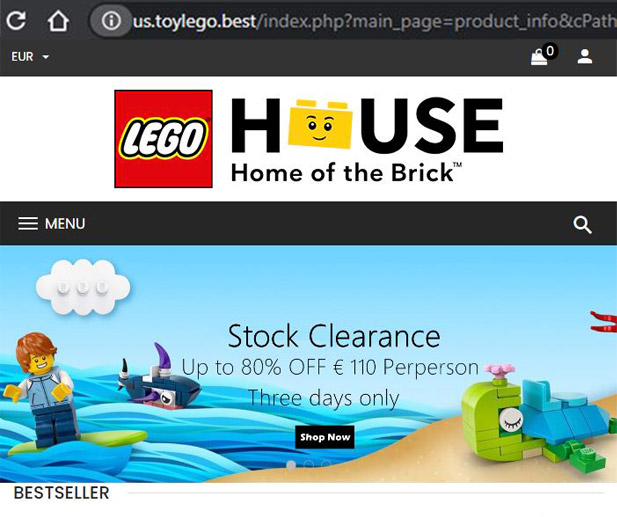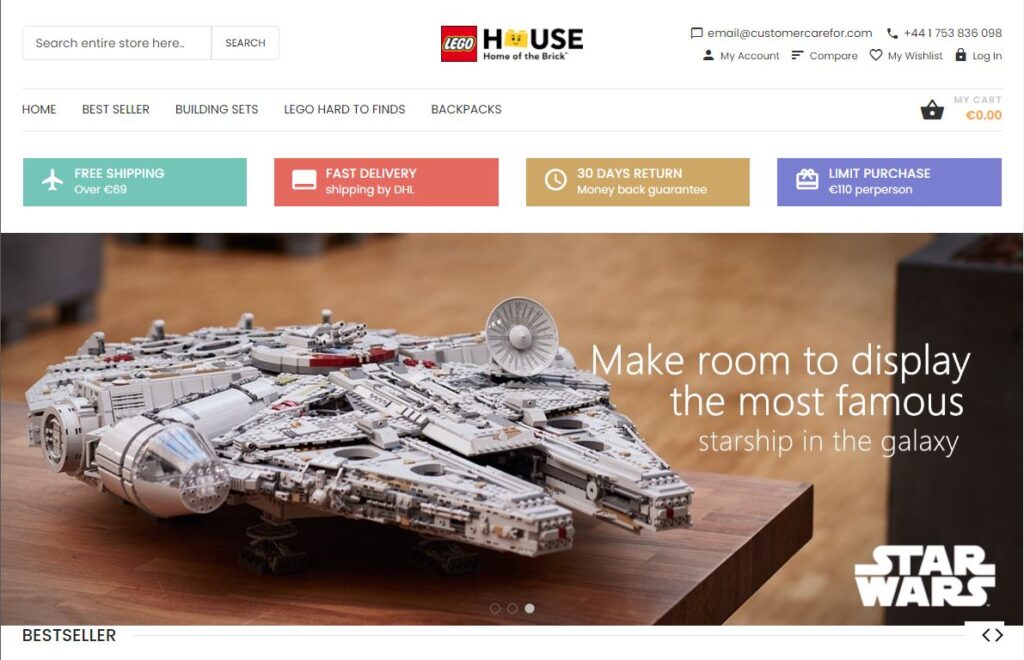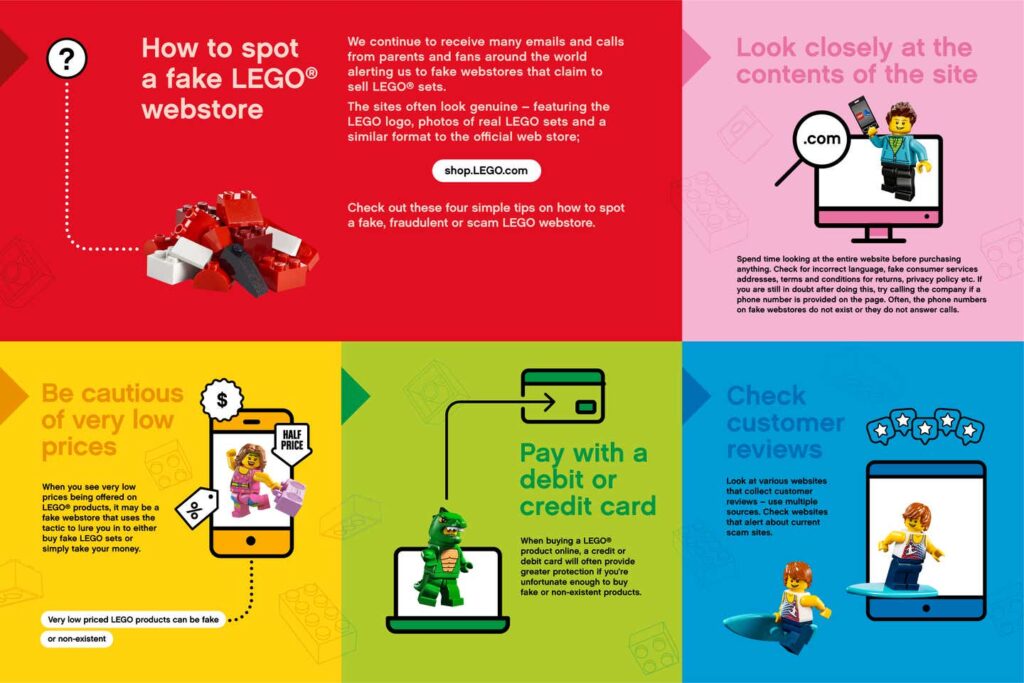LEGO enthusiasts and collectors always have to be on the lookout for the ever-present danger of online scams related to the sale of LEGO sets. Falling into the trap of these sites is much easier than one might think, due to the desire to save money and also a series of strategies implemented by the site itself to convince the user to trust and buy.
How to spot a fake or fraudulent LEGO website.
Recognizing a fraudulent LEGO site is not always immediate, especially if you are convinced by a series of precautions taken to confuse the user or if you are new to online shopping.
Here are the main elements to pay attention to, that we will deepen in this guide:
- Check the name and domain of the suspicious website
- Check for suspicious elements
- Avoid the trap of prices that are too low
- Check reviews from other customers
- What NOT to do on a suspicious site
- What are the most reliable and safe sites to buy LEGO
- The official LEGO guidelines VS fake sites
- Conclusions
1: Check the name and domain of the suspicious website
This step is often sufficient to immediately expose a fraudulent sales site. LEGO Group guidelines (aka Fair Play policies) prohibit websites and sellers from having the term “LEGO” in their name or web address (domain).
At this point, if we come across a site that looks like this during navigation…

..we can start to be suspicious.
Let’s focus on the address bar: the web address (also called the domain) includes the term “LEGO” even though it is not one of the well-known LEGO-owned sites, and it is followed by a suspicious “.best” instead of a classic “.com”
When you come across a web address that includes the term “LEGO” and ends differently from the classic “.com” (or “.it”, “.de”, “.es”, “.fr”… you get it), you need to pay attention because it is almost certain that you are inside a fraudulent site created specifically with the intention of taking money from inattentive users.
These fraudulent sites are created very frequently and usually manage to stay online for a short time before being detected and obscured. This explains the use of more exotic domains such as “.toys”, “.best”, “.star”, “.club” and others like them: once obscured, the scam site moves as it is to a new address, operating undisturbed until it is obscured again.
For this reason, these fraudulent sites often reappear in a “raw” manner, showing together with particular web addresses also invalid security certificates and unprotected connections.
2: Carefully check the website pages for suspicious elements
Scammers often try to reassure the users by inserting some elements among the pages of the site that are usually “synonymous with quality”, such as a section dedicated to customer services or alerts that reassure the user about the speed of shipping or return.
In most cases, these call centers do not exist: often, you get no response by sending emails to the addresses indicated, and no answer by phone if you try to call these numbers.

Here’s a screenshot of a fake LEGO deals website where we can immediately notice that the LEGO logo is included in the site name despite it not being a known LEGO-owned site, and that there are notices such as “money back guarantee”, “fast delivery”, and “free shipping”, but also a non-functioning email address and phone number for customer service. These are all elements that aim to convince suspicious users of the site’s legitimacy.
3: Be wary of prices that seem too good to be true
Those who follow our Telegram channel surely have noticed that discounts on LEGO sets rarely reach peaks of 40% and 50%: these are particularly rare events.
Keeping this detail in mind, we show you this screenshot of yet another fake site that we identified during the writing of this guide:

Let’s look together at the discounts offered. The first set on the list is the Hogwarts Castle: a starting price of €349.99 and a final price of €49.99, which would be an 85% discount! You will understand that it is highly surreal for a set with such a high cost to be sold at such a low price.
All the advice we have given you so far is crucial for quickly identifying fake deals. Let’s give another practical example of a fraudulent offer we came across during our research:

For example, this offer: LEGO Star Wars Millennium Falcon, sold for €44.99, representing a discount of 95% off the raccomended retail price! It is simply impossible for one of the most expensive sets, which has become famous for its high cost and its limited availability even in classic online stores, to be sold at such a low price.
The image that follows (as well as the previous one) contains some elements that immediately arouse suspicion:
- The final price is too low
- The starting price (list price) is incorrect
- Positive reviews of the set are indicated, but there is no trace of them on the page
- A “Max: 4” is indicated, meaning a maximum limit of sets that can be purchased

This last element is one of those included in an attempt to “reassure” the potential skeptical user: in practice, the website tries to reassure the user by suggesting that they can take advantage of the deal, but not too much. In this way, the user is encouraged to take advantage of the offer, also pressured by the presence of a timer placed right next to the offer, which adds haste and pressure to the situation.
4: Check the reviews of other customers
The most important advice we feel we can give you, in case you suspect that you have come across a fraudulent website, is to search for reliable reviews on specialized websites such as TrustPilot.
If the online reviews are poor or absent, we advise against registering on the site or making a purchase.
5: What NOT to do on a suspicious website
What we do NOT recommend is proceeding directly to the checkout phase of the set. Even testing the quality of the site by making a test purchase is definitely not recommended, not so much for the potential loss of the amount spent, but for the much more serious theft of data that could follow at the end of payment.
In this scenario, the user finds himself having certainly lost the amount related to the purchase of the set, but there is a concrete possibility of compromising the entire bank account.
In general, we also advise against simply registering on such a site to avoid giving any kind of personal information to malicious actors.
6: What are the most reliable and safe sites to but LEGO online?
If you want to be safe when shopping for discounted LEGO sets, we strongly rcccomend you to join our free Telegram Channel, where you will find only promotions and deals from reccomended and trustful online stores!

Nerver miss a LEGO Deal: join our Telegram Channel for FREE!
Every day we scrape the web looking for the best LEGO offers, but sometimes the best sales may end quickly.
By subscribing to our free Telegram Channel you will receive a notification every time there is a LEGO deal, so you can be sure you never miss one!
7: The official LEGO guidelines against fake sites
On the official LEGO website, there is also a small guide that explains how to recognize and defend against fake LEGO sites.

The tips given by LEGO are as follows, and essentially follow those we have already outlined in this guide.
We are currently receiving several emails and calls from parents and fans around the world regarding fake LEGO® webstores claiming to sell LEGO products often at very low prices.
The sites, which are usually promoted on popular social media sites, often look genuine. Many feature the LEGO logo, theme logos, photos of real LEGO sets and a similar design to the official LEGO webstore www.shop.LEGO.com.
We’re doing everything we can to protect consumers from fraud, and we take the issue of fraudulent and scam websites very seriously. We’re working harder than ever to identify and report as many of these sites as possible and the following simple steps can help you spot a fake, fraudulent or scam LEGO webstore.
- Look closely at the contents of the site. Spend time looking at the entire website before purchasing anything. Check for incorrect language, fake consumer services addresses, terms and conditions for returns, privacy policy etc. If you are still in doubt after doing this, try calling the company if a phone number is provided on the page. Often, the phone numbers on fake webstores do not exist or they do not answer calls.
- Be cautious of very low prices. When you see very low prices being offered on LEGO products, it may be a fake webstore that uses the tactic to lure you in to either buy fake LEGO sets or simply take your money.
- Pay with debit or credit card. When buying a LEGO product online, a credit or debit card will often provide greater protection if you’re unfortunate enough to buy fake or non-existent products.
- Check customer reviews. Look at various websites that collect customer reviews – use multiple sources. Check websites that alert about current scam sites.
If you see a potential fraudulent or scam website claiming to sell LEGO products, please contact customer service.
Conclusions
In conclusion, it is essential to be vigilant when buying LEGO sets online to avoid falling prey to scammers. One must check the site’s domain, security certificate, and suspicious elements on the site. It is crucial to be wary of prices that seem too good to be true and check reviews from other customers before making a purchase. Additionally, one must avoid making any transactions or sharing personal information on suspicious sites. It is recommended to only purchase from well-known and reliable LEGO sites. By following these guidelines, LEGO enthusiasts and collectors can safely and securely purchase LEGO sets online without the fear of getting scammed.
Source: www.affaridanerd.it





